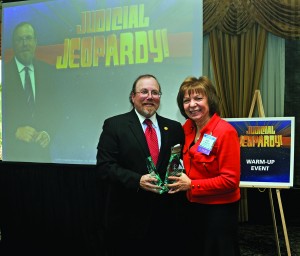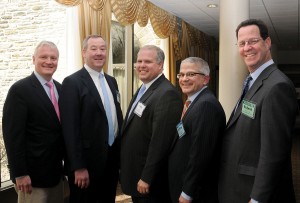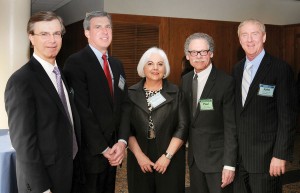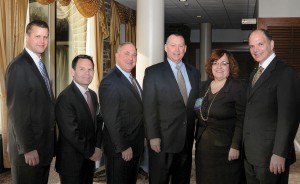
President,
The Brownstein Corporation
The Seventh Annual Education & Networking Conference was held at the Villanova University Conference Center on March 27, 2014, under the auspices of ABF Journal, the NY Institute of Credit, and the Philadelphia Chapters of TMA and CFA, with more than 80 judges, lenders, factors, attorneys, consultants and others in attendance. This was the largest Villanova conference to date, with a sell-out crowd of active participants.
A full afternoon of programs was provided, beginning with a rousing lunchtime game of “Judicial Jeopardy,” featuring bankruptcy judges from the Districts of New Jersey and Pennsylvania. Bankruptcy Judge Michael B. Kaplan of the District of New Jersey played the Alex Trebek role. The contestants included Judges Christine M. Gravelle and Judith H. Wizmur of the District of New Jersey and Chief Judge Eric L. Frank of the Eastern District of Pennsylvania. Contestants were peppered with difficult questions on American history, especially about bankruptcy, such as, “These two Supreme Court justices, separated by 44 years between their terms, are the only two justices to share a name,” (Answer: Who are John Marshall Harlan [1877-1911] and John Marshall Harlan [1955-1971]), and “The best charioteer couldn’t save this movie company from bankruptcy in 2010,” (Answer: Who is Metro-Goldwyn-Mayer, Inc. [MGM]).

Following lunch, a panel of experts on “Restructuring – What’s New is Getting Old” led a discussion on UCC Article 9 sales, Assignments for the Benefit of Creditors (ABCs), Compositions, Prepacks and other restructuring alternatives. Moderated by Rob Katz, managing director at Executive Sounding Board Associates in Philadelphia, the panel included Jeffrey C. Hampton, co-chair of the Bankruptcy and Restructuring Department at the Saul Ewing law firm in Philadelphia; Terry Kohler, director at SSG Capital Advisors in West Conshohocken, PA; John R. Buck, managing director of Transactional Development at Versa Capital Management in Philadelphia; and Patrick A. McGovern, senior vice president of the Credit Resolution Group of Wells Fargo Bank in Philadelphia.

Using bankruptcy just to gain access to a sale under §363 continues to be a popular method to “cauterize” assets, i.e., cleanse them of successor liabilities. There are a large number of potential debt buyers available through which lenders can monetize their assets, which has affected the relative attractiveness of going through a restructuring instead. In fact, there is a superabundance of funds available to purchase distressed debt as well as to make distressed investments, disfavoring restructuring for the time being.
After a break, attorney Paul H. Shur, a partner at the law firm of Windels, Marx, Lane & Mittendorf in New York City, moderated a lenders panel on customer trends and issues with industry-specific observations by Robert Bushey, senior vice president of the Mid-Atlantic market at Santander Bank in Philadelphia; Michael Coiley, managing director of Healthcare Corporate Finance at CIT Group in Livingston, NJ; John DePledge, business head of Asset Based Lending at Citibank in Long Island City, NY; and Andrea Petro, executive vice president, Lender Finance Division manager at Wells Fargo Capital Finance.

Specific deal examples of each type were discussed in terms of their strengths and weaknesses, and how easy or difficult they were to get completed. Petro commented that Wells Fargo was previously alone in providing leverage to finance companies, whereas now there are currently other players in the marketplace. She provided an overview of four recent transactions, including one in which Wells Fargo financed the acquisition by a BDC entering the specialty commercial finance space. She described the regulatory incentives for BDCs, including pending legislation to ease limitations on leverage, as well as increased regulation that may reduce the percentage of banks in this sector.
Coiley remarked that the healthcare accounts for 18% of the country’s GDP, and is projected to increase to 20% by 2022. The recently enacted Affordable Care Act’s focus on increasing the number of insured lives should expand the payor base, and from a macro viewpoint, should result in an expanding loan market in the future. He added that since healthcare is a heavily regulated industry, healthcare lending involves key risks, such as the possibility of government action that can alter reimbursement of providers with the “stroke of the pen.”
DePledge summarized two representative international transactions, and in general discussed Citibank’s comparative advantage when it comes to serving foreign companies doing business in this country, as well as domestic companies with foreign subsidiaries, vendors and customers. Bushey discussed the cyclical nature of real estate-related businesses such as construction and building products. As Santander is active in New Jersey and New York, among other regions, he discussed some of the issues created by Hurricane Sandy in terms of collateral and profitability.

Howard Brod Brownstein is a Certified Turnaround Professional, the president of The Brownstein Corp. and a contributing editor of ABF Journal. He can be reached at [email protected].
Megen Donovan is associate editor of ABF Journal.
